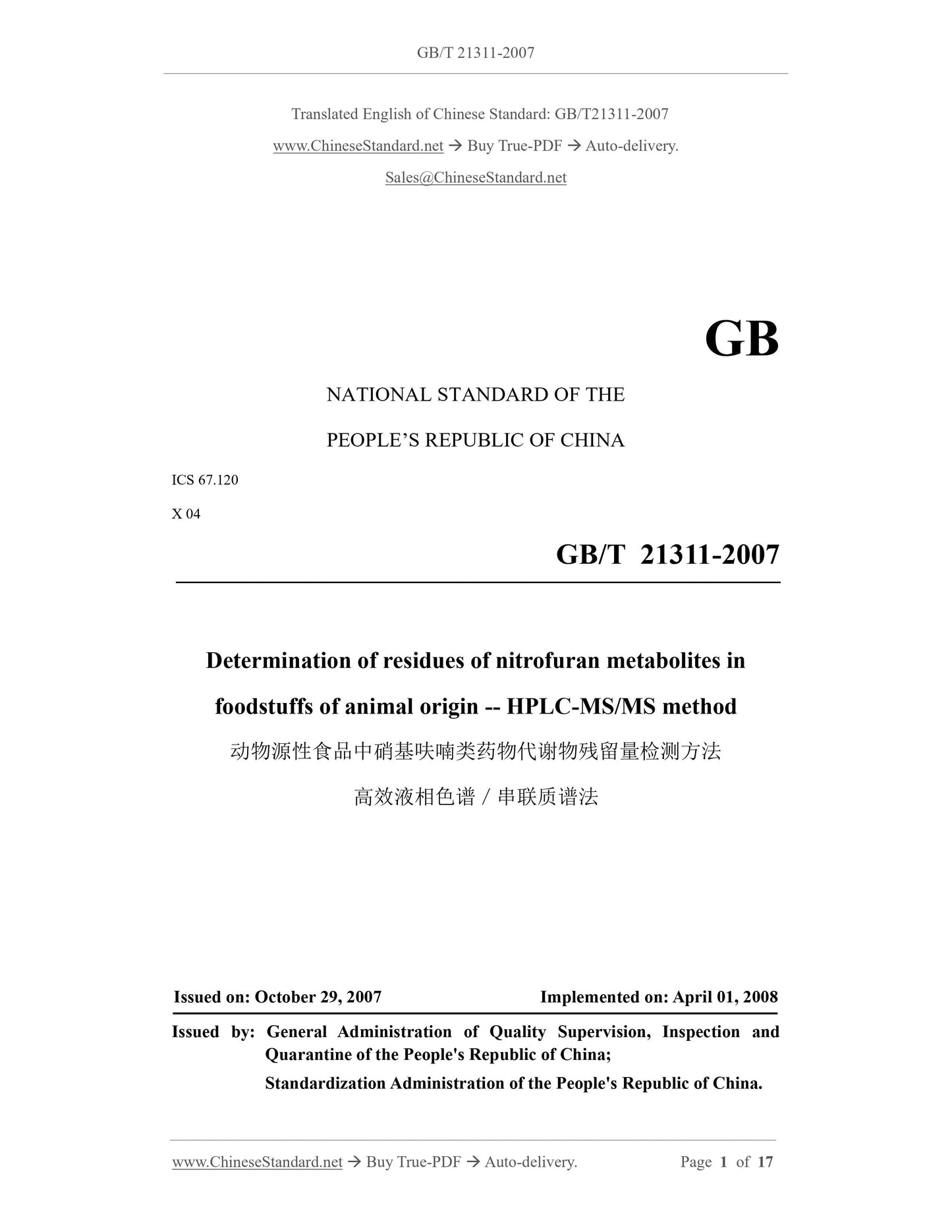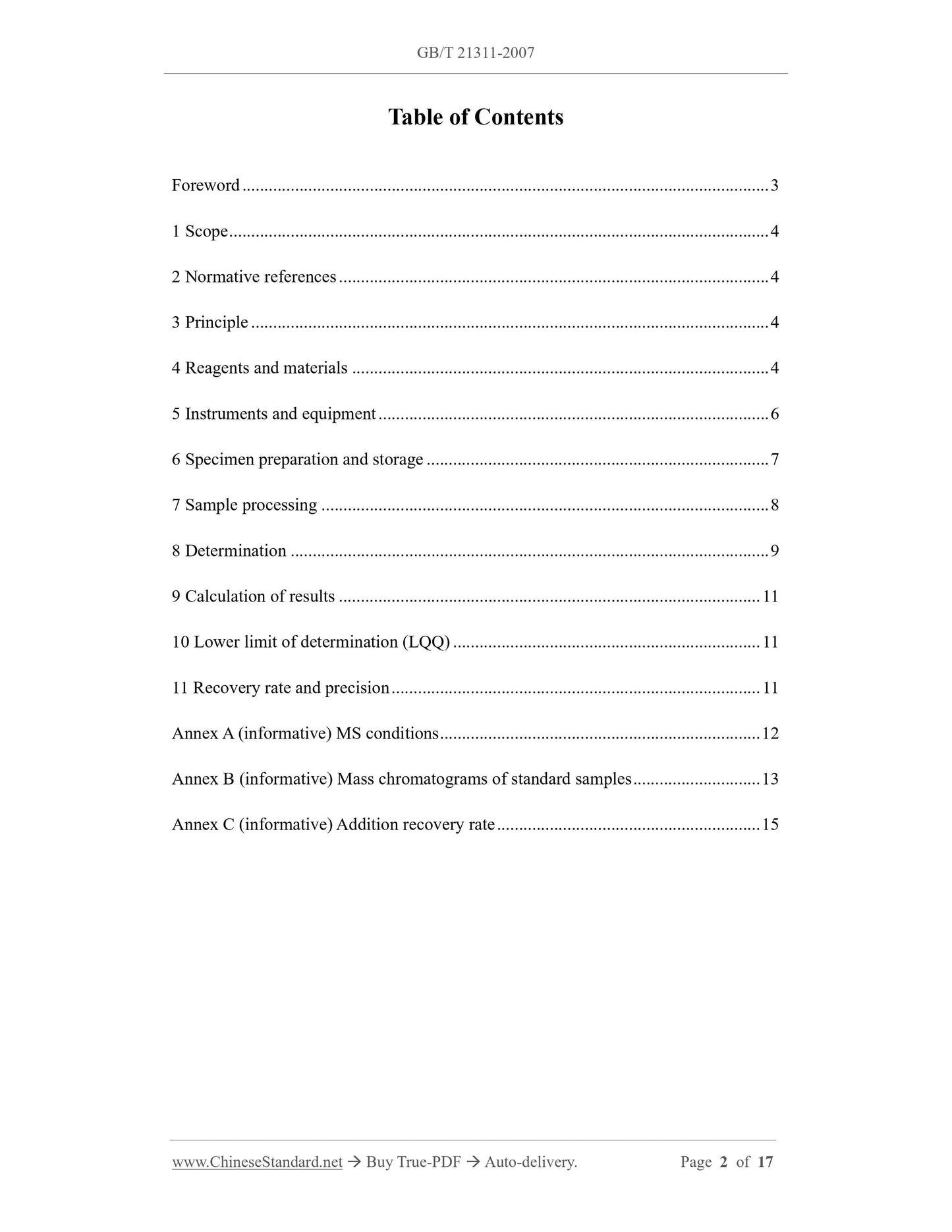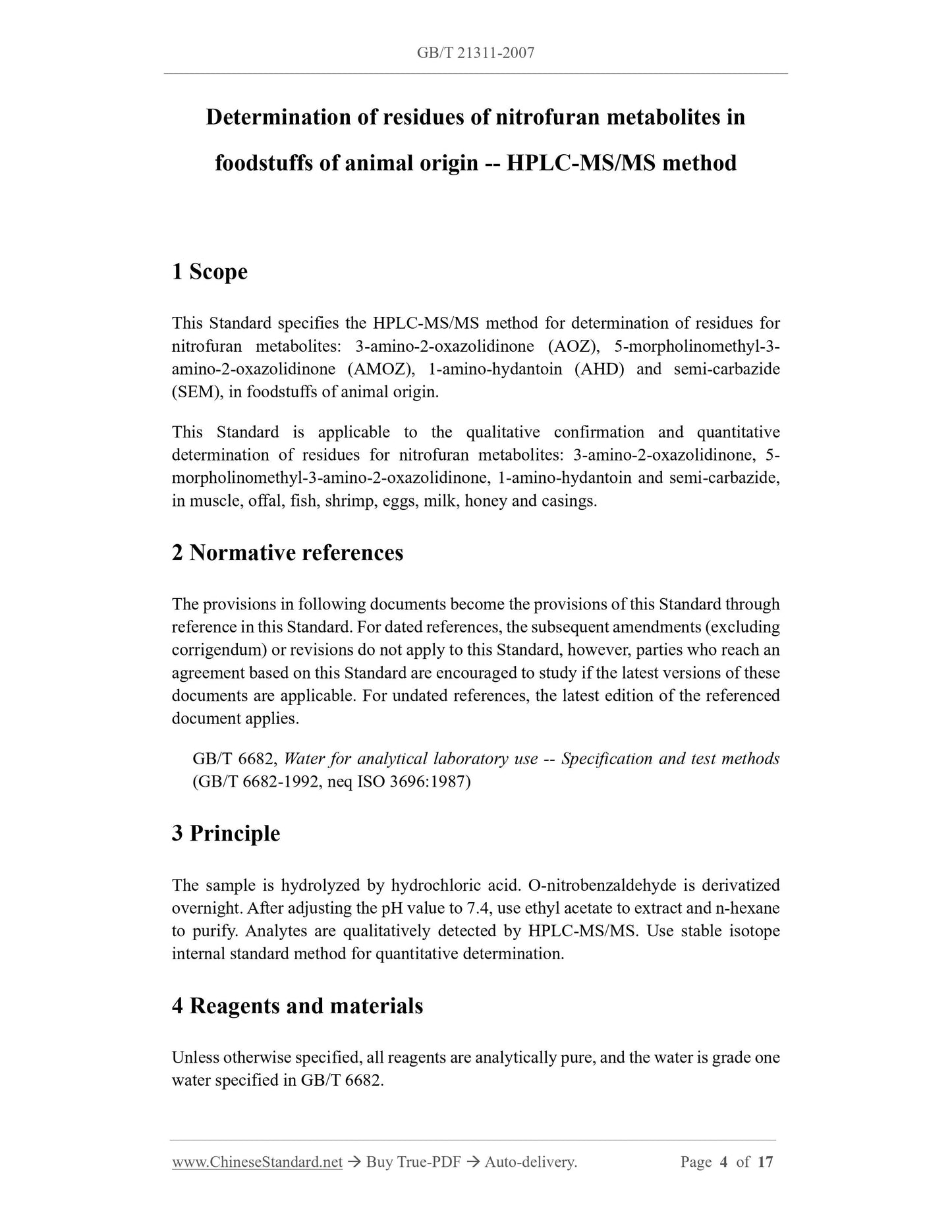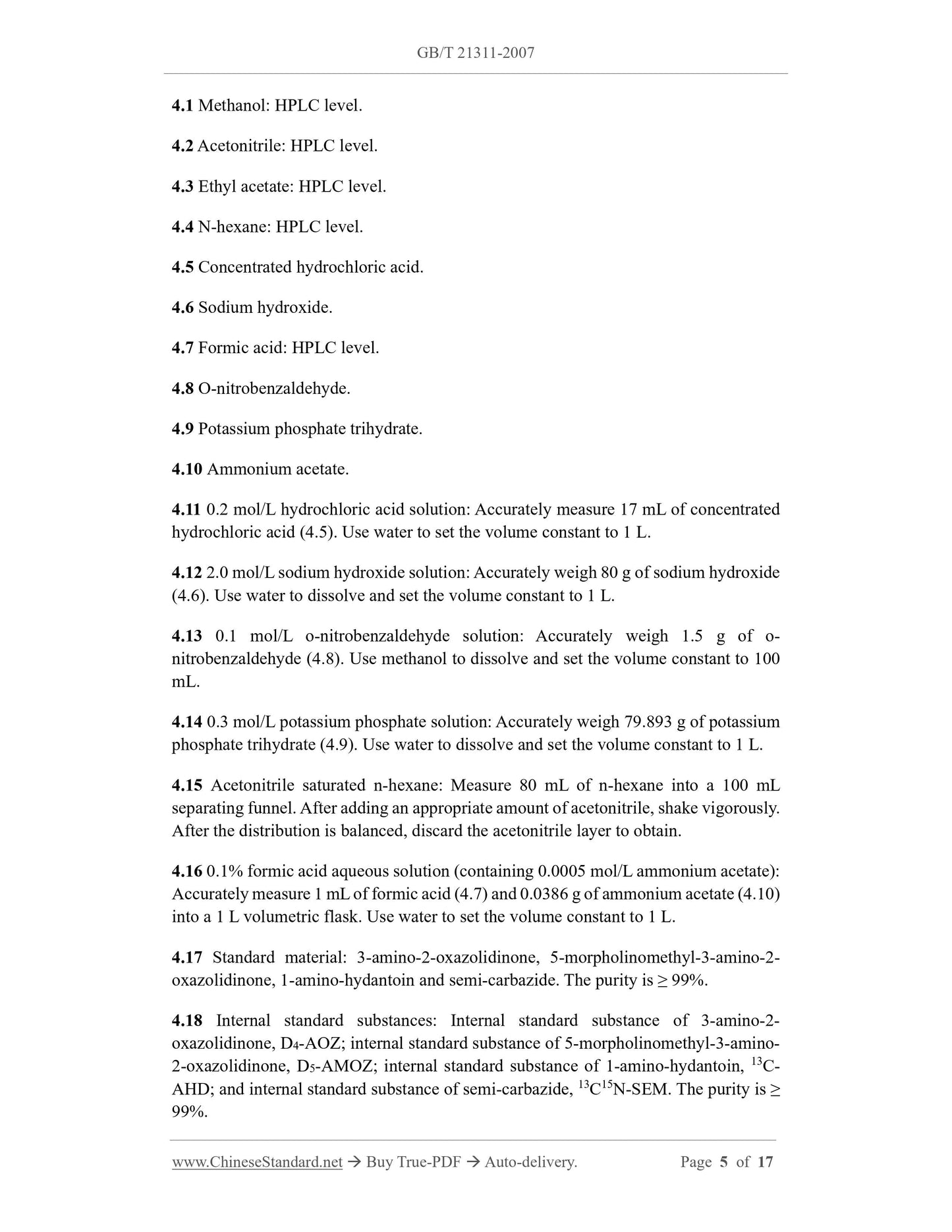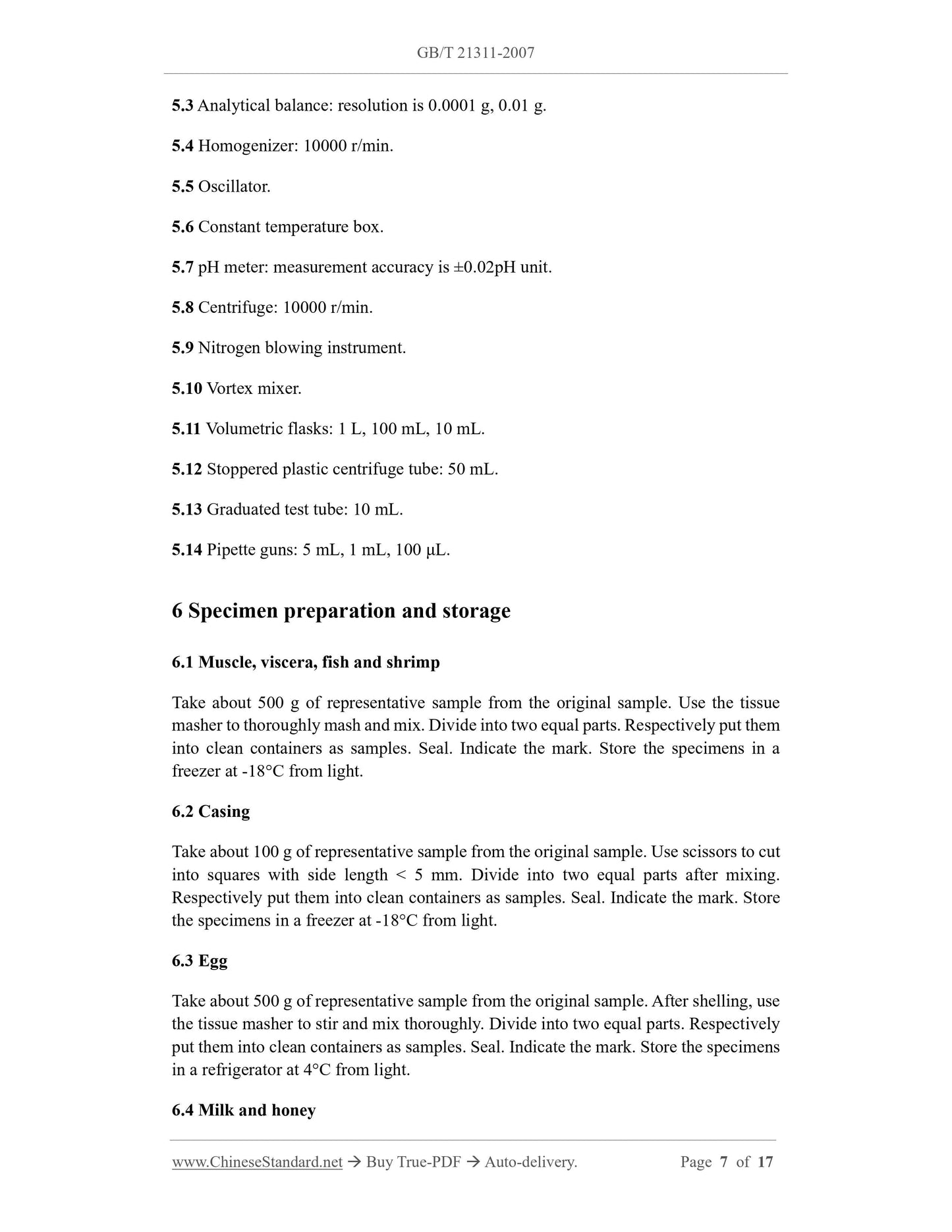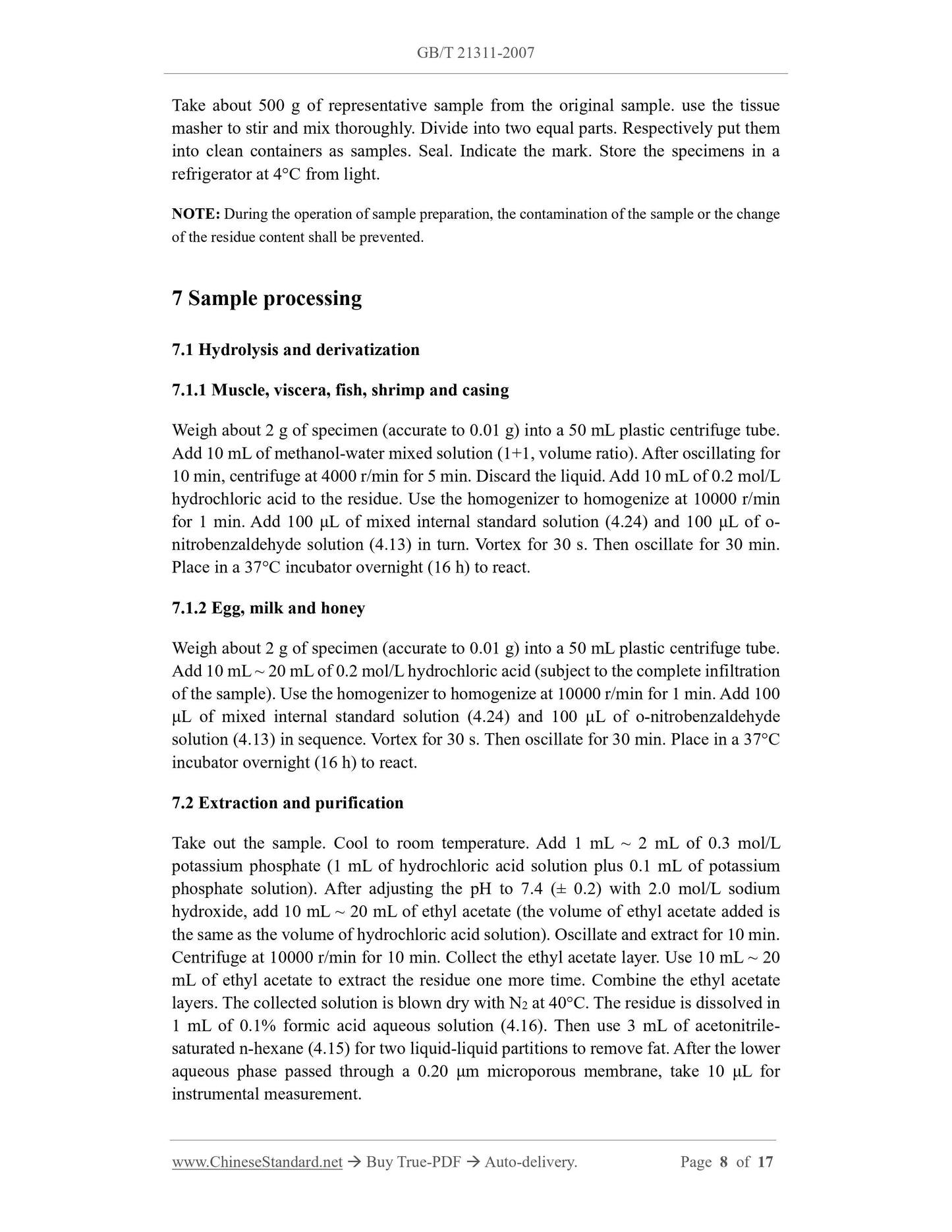1
/
su
6
PayPal, credit cards. Download editable-PDF and invoice in 1 second!
GB/T 21311-2007 English PDF (GBT21311-2007)
GB/T 21311-2007 English PDF (GBT21311-2007)
Prezzo di listino
$70.00 USD
Prezzo di listino
Prezzo scontato
$70.00 USD
Prezzo unitario
/
per
Spese di spedizione calcolate al check-out.
Impossibile caricare la disponibilità di ritiro
Delivery: 3 seconds. Download true-PDF + Invoice.
Get QUOTATION in 1-minute: Click GB/T 21311-2007
Historical versions: GB/T 21311-2007
Preview True-PDF (Reload/Scroll if blank)
GB/T 21311-2007: Determination of residues of nitrofuran metabolites in foodstuffs of animal origin -- HPLC-MS/MS method
GB/T 21311-2007
GB
NATIONAL STANDARD OF THE
PEOPLE’S REPUBLIC OF CHINA
ICS 67.120
X 04
Determination of residues of nitrofuran metabolites in
foodstuffs of animal origin -- HPLC-MS/MS method
ISSUED ON: OCTOBER 29, 2007
IMPLEMENTED ON: APRIL 01, 2008
Issued by: General Administration of Quality Supervision, Inspection and
Quarantine of the People's Republic of China;
Standardization Administration of the People's Republic of China.
Table of Contents
Foreword ... 3
1 Scope ... 4
2 Normative references ... 4
3 Principle ... 4
4 Reagents and materials ... 4
5 Instruments and equipment ... 6
6 Specimen preparation and storage ... 7
7 Sample processing ... 8
8 Determination ... 9
9 Calculation of results ... 11
10 Lower limit of determination (LQQ) ... 11
11 Recovery rate and precision ... 11
Annex A (informative) MS conditions ... 12
Annex B (informative) Mass chromatograms of standard samples ... 13
Annex C (informative) Addition recovery rate ... 15
Determination of residues of nitrofuran metabolites in
foodstuffs of animal origin -- HPLC-MS/MS method
1 Scope
This Standard specifies the HPLC-MS/MS method for determination of residues for
nitrofuran metabolites: 3-amino-2-oxazolidinone (AOZ), 5-morpholinomethyl-3-
amino-2-oxazolidinone (AMOZ), 1-amino-hydantoin (AHD) and semi-carbazide
(SEM), in foodstuffs of animal origin.
This Standard is applicable to the qualitative confirmation and quantitative
determination of residues for nitrofuran metabolites: 3-amino-2-oxazolidinone, 5-
morpholinomethyl-3-amino-2-oxazolidinone, 1-amino-hydantoin and semi-carbazide,
in muscle, offal, fish, shrimp, eggs, milk, honey and casings.
2 Normative references
The provisions in following documents become the provisions of this Standard through
reference in this Standard. For dated references, the subsequent amendments (excluding
corrigendum) or revisions do not apply to this Standard, however, parties who reach an
agreement based on this Standard are encouraged to study if the latest versions of these
documents are applicable. For undated references, the latest edition of the referenced
document applies.
GB/T 6682, Water for analytical laboratory use -- Specification and test methods
(GB/T 6682-1992, neq ISO 3696:1987)
3 Principle
The sample is hydrolyzed by hydrochloric acid. O-nitrobenzaldehyde is derivatized
overnight. After adjusting the pH value to 7.4, use ethyl acetate to extract and n-hexane
to purify. Analytes are qualitatively detected by HPLC-MS/MS. Use stable isotope
internal standard method for quantitative determination.
4 Reagents and materials
Unless otherwise specified, all reagents are analytically pure, and the water is grade one
water specified in GB/T 6682.
4.1 Methanol: HPLC level.
4.2 Acetonitrile: HPLC level.
4.3 Ethyl acetate: HPLC level.
4.4 N-hexane: HPLC level.
4.5 Concentrated hydrochloric acid.
4.6 Sodium hydroxide.
4.7 Formic acid: HPLC level.
4.8 O-nitrobenzaldehyde.
4.9 Potassium phosphate trihydrate.
4.10 Ammonium acetate.
4.11 0.2 mol/L hydrochloric acid solution: Accurately measure 17 mL of concentrated
hydrochloric acid (4.5). Use water to set the volume constant to 1 L.
4.12 2.0 mol/L sodium hydroxide solution: Accurately weigh 80 g of sodium hydroxide
(4.6). Use water to dissolve and set the volume constant to 1 L.
4.13 0.1 mol/L o-nitrobenzaldehyde solution: Accurately weigh 1.5 g of o-
nitrobenzaldehyde (4.8). Use methanol to dissolve and set the volume constant to 100
mL.
4.14 0.3 mol/L potassium phosphate solution: Accurately weigh 79.893 g of potassium
phosphate trihydrate (4.9). Use water to dissolve and set the volume constant to 1 L.
4.15 Acetonitrile saturated n-hexane: Measure 80 mL of n-hexane into a 100 mL
separating funnel. After adding an appropriate amount of acetonitrile, shake vigorously.
After the distribution is balanced, discard the acetonitrile layer to obtain.
4.16 0.1% formic acid aqueous solution (containing 0.0005 mol/L ammonium acetate):
Accurately measure 1 mL of formic acid (4.7) and 0.0386 g of ammonium acetate (4.10)
into a 1 L volumetric flask. Use water to set the volume constant to 1 L.
4.17 Standard material: 3-amino-2-oxazolidinone, 5-morpholinomethyl-3-amino-2-
oxazolidinone, 1-amino-hydantoin and semi-carbazide. The purity is ≥ 99%.
4.18 Internal standard substances: Internal standard substance of 3-amino-2-
oxazolidinone, D4-AOZ; internal standard substance of 5-morpholinomethyl-3-amino-
2-oxazolidinone, D5-AMOZ; internal standard substance of 1-amino-hydantoin, 13C-
AHD; and internal standard substance of semi-carbazide, 13C15N-SEM. The purity is ≥
99%.
5.3 Analytical balance: resolution is 0.0001 g, 0.01 g.
5.4 Homogenizer: 10000 r/min.
5.5 Oscillator.
5.6 Constant temperature box.
5.7 pH meter: measurement accuracy is ±0.02pH unit.
5.8 Centrifuge: 10000 r/min.
5.9 Nitrogen blowing instrument.
5.10 Vortex mixer.
5.11 Volumetric flasks: 1 L, 100 mL, 10 mL.
5.12 Stoppered plastic centrifuge tube: 50 mL.
5.13 Graduated test tube: 10 mL.
5.14 Pipette guns: 5 mL, 1 mL, 100 μL.
6 Specimen preparation and storage
6.1 Muscle, viscera, fish and shrimp
Take about 500 g of representative sample from the original sample. Use the tissue
masher to thoroughly mash and mix. Divide into two equal parts. Respectively put them
into clean containers as samples. Seal. Indicate the mark. Store the specimens in a
freezer at -18°C from light.
6.2 Casing
Take about 100 g of representative sample from the original sample. Use scissors to cut
into squares with side length < 5 mm. Divide into two equal parts after mixing.
Respectively put them into clean containers as samples. Seal. Indicate the mark. Store
the specimens in a freezer at -18°C from light.
6.3 Egg
Take about 500 g of representative sample from the original sample. After shelling, use
the tissue masher to stir and mix thoroughly. Divide into two equal parts. Respectively
put them into clean containers as samples. Seal. Indicate the mark. Store the specimens
in a refrigerator at 4°C from light.
6.4 Milk and honey
Take about 500 g of representative sample from the original sample. use the tissue
masher to stir and mix thoroughly. Divide into two equal parts. Respectively put them
into clean containers as samples. Seal. Indicate the mark. Store the specimens in a
refrigerator at 4°C from light.
NOTE: During the operation of sample preparation, the contamination of the sample or the change
of the residue content shall be prevented.
7 Sample processing
7.1 Hydrolysis and derivatization
7.1.1 Muscle, viscera, fish, shrimp and casing
Weigh about 2 g of specimen (accurate to 0.01 g) into a 50 mL plastic centrifuge tube.
Add 10 mL of methanol-water mixed solution (1+1, volume ratio). After oscillating for
10 min, centrifuge at 4000 r/min for 5 min. Discard the liquid. Add 10 mL of 0.2 mol/L
hydrochloric acid to the residue. Use the homogenizer to homogenize at 10000 r/min
for 1 min. Add 100 μL of mixed internal standard solution (4.24) and 100 μL of o-
nitrobenzaldehyde solution (4.13) in turn. Vortex for 30 s. Then oscillate for 30 min.
Place in a 37°C incubator overnight (16 h) to react.
7.1.2 Egg, milk and honey
Weigh about 2 g of specimen (accurate to 0.01 g) into a 50 mL plastic centrifuge tube.
Add 10 mL ~ 20 mL of 0.2 mol/L hydrochloric acid (subject to the complete infiltration
of the ...
Get QUOTATION in 1-minute: Click GB/T 21311-2007
Historical versions: GB/T 21311-2007
Preview True-PDF (Reload/Scroll if blank)
GB/T 21311-2007: Determination of residues of nitrofuran metabolites in foodstuffs of animal origin -- HPLC-MS/MS method
GB/T 21311-2007
GB
NATIONAL STANDARD OF THE
PEOPLE’S REPUBLIC OF CHINA
ICS 67.120
X 04
Determination of residues of nitrofuran metabolites in
foodstuffs of animal origin -- HPLC-MS/MS method
ISSUED ON: OCTOBER 29, 2007
IMPLEMENTED ON: APRIL 01, 2008
Issued by: General Administration of Quality Supervision, Inspection and
Quarantine of the People's Republic of China;
Standardization Administration of the People's Republic of China.
Table of Contents
Foreword ... 3
1 Scope ... 4
2 Normative references ... 4
3 Principle ... 4
4 Reagents and materials ... 4
5 Instruments and equipment ... 6
6 Specimen preparation and storage ... 7
7 Sample processing ... 8
8 Determination ... 9
9 Calculation of results ... 11
10 Lower limit of determination (LQQ) ... 11
11 Recovery rate and precision ... 11
Annex A (informative) MS conditions ... 12
Annex B (informative) Mass chromatograms of standard samples ... 13
Annex C (informative) Addition recovery rate ... 15
Determination of residues of nitrofuran metabolites in
foodstuffs of animal origin -- HPLC-MS/MS method
1 Scope
This Standard specifies the HPLC-MS/MS method for determination of residues for
nitrofuran metabolites: 3-amino-2-oxazolidinone (AOZ), 5-morpholinomethyl-3-
amino-2-oxazolidinone (AMOZ), 1-amino-hydantoin (AHD) and semi-carbazide
(SEM), in foodstuffs of animal origin.
This Standard is applicable to the qualitative confirmation and quantitative
determination of residues for nitrofuran metabolites: 3-amino-2-oxazolidinone, 5-
morpholinomethyl-3-amino-2-oxazolidinone, 1-amino-hydantoin and semi-carbazide,
in muscle, offal, fish, shrimp, eggs, milk, honey and casings.
2 Normative references
The provisions in following documents become the provisions of this Standard through
reference in this Standard. For dated references, the subsequent amendments (excluding
corrigendum) or revisions do not apply to this Standard, however, parties who reach an
agreement based on this Standard are encouraged to study if the latest versions of these
documents are applicable. For undated references, the latest edition of the referenced
document applies.
GB/T 6682, Water for analytical laboratory use -- Specification and test methods
(GB/T 6682-1992, neq ISO 3696:1987)
3 Principle
The sample is hydrolyzed by hydrochloric acid. O-nitrobenzaldehyde is derivatized
overnight. After adjusting the pH value to 7.4, use ethyl acetate to extract and n-hexane
to purify. Analytes are qualitatively detected by HPLC-MS/MS. Use stable isotope
internal standard method for quantitative determination.
4 Reagents and materials
Unless otherwise specified, all reagents are analytically pure, and the water is grade one
water specified in GB/T 6682.
4.1 Methanol: HPLC level.
4.2 Acetonitrile: HPLC level.
4.3 Ethyl acetate: HPLC level.
4.4 N-hexane: HPLC level.
4.5 Concentrated hydrochloric acid.
4.6 Sodium hydroxide.
4.7 Formic acid: HPLC level.
4.8 O-nitrobenzaldehyde.
4.9 Potassium phosphate trihydrate.
4.10 Ammonium acetate.
4.11 0.2 mol/L hydrochloric acid solution: Accurately measure 17 mL of concentrated
hydrochloric acid (4.5). Use water to set the volume constant to 1 L.
4.12 2.0 mol/L sodium hydroxide solution: Accurately weigh 80 g of sodium hydroxide
(4.6). Use water to dissolve and set the volume constant to 1 L.
4.13 0.1 mol/L o-nitrobenzaldehyde solution: Accurately weigh 1.5 g of o-
nitrobenzaldehyde (4.8). Use methanol to dissolve and set the volume constant to 100
mL.
4.14 0.3 mol/L potassium phosphate solution: Accurately weigh 79.893 g of potassium
phosphate trihydrate (4.9). Use water to dissolve and set the volume constant to 1 L.
4.15 Acetonitrile saturated n-hexane: Measure 80 mL of n-hexane into a 100 mL
separating funnel. After adding an appropriate amount of acetonitrile, shake vigorously.
After the distribution is balanced, discard the acetonitrile layer to obtain.
4.16 0.1% formic acid aqueous solution (containing 0.0005 mol/L ammonium acetate):
Accurately measure 1 mL of formic acid (4.7) and 0.0386 g of ammonium acetate (4.10)
into a 1 L volumetric flask. Use water to set the volume constant to 1 L.
4.17 Standard material: 3-amino-2-oxazolidinone, 5-morpholinomethyl-3-amino-2-
oxazolidinone, 1-amino-hydantoin and semi-carbazide. The purity is ≥ 99%.
4.18 Internal standard substances: Internal standard substance of 3-amino-2-
oxazolidinone, D4-AOZ; internal standard substance of 5-morpholinomethyl-3-amino-
2-oxazolidinone, D5-AMOZ; internal standard substance of 1-amino-hydantoin, 13C-
AHD; and internal standard substance of semi-carbazide, 13C15N-SEM. The purity is ≥
99%.
5.3 Analytical balance: resolution is 0.0001 g, 0.01 g.
5.4 Homogenizer: 10000 r/min.
5.5 Oscillator.
5.6 Constant temperature box.
5.7 pH meter: measurement accuracy is ±0.02pH unit.
5.8 Centrifuge: 10000 r/min.
5.9 Nitrogen blowing instrument.
5.10 Vortex mixer.
5.11 Volumetric flasks: 1 L, 100 mL, 10 mL.
5.12 Stoppered plastic centrifuge tube: 50 mL.
5.13 Graduated test tube: 10 mL.
5.14 Pipette guns: 5 mL, 1 mL, 100 μL.
6 Specimen preparation and storage
6.1 Muscle, viscera, fish and shrimp
Take about 500 g of representative sample from the original sample. Use the tissue
masher to thoroughly mash and mix. Divide into two equal parts. Respectively put them
into clean containers as samples. Seal. Indicate the mark. Store the specimens in a
freezer at -18°C from light.
6.2 Casing
Take about 100 g of representative sample from the original sample. Use scissors to cut
into squares with side length < 5 mm. Divide into two equal parts after mixing.
Respectively put them into clean containers as samples. Seal. Indicate the mark. Store
the specimens in a freezer at -18°C from light.
6.3 Egg
Take about 500 g of representative sample from the original sample. After shelling, use
the tissue masher to stir and mix thoroughly. Divide into two equal parts. Respectively
put them into clean containers as samples. Seal. Indicate the mark. Store the specimens
in a refrigerator at 4°C from light.
6.4 Milk and honey
Take about 500 g of representative sample from the original sample. use the tissue
masher to stir and mix thoroughly. Divide into two equal parts. Respectively put them
into clean containers as samples. Seal. Indicate the mark. Store the specimens in a
refrigerator at 4°C from light.
NOTE: During the operation of sample preparation, the contamination of the sample or the change
of the residue content shall be prevented.
7 Sample processing
7.1 Hydrolysis and derivatization
7.1.1 Muscle, viscera, fish, shrimp and casing
Weigh about 2 g of specimen (accurate to 0.01 g) into a 50 mL plastic centrifuge tube.
Add 10 mL of methanol-water mixed solution (1+1, volume ratio). After oscillating for
10 min, centrifuge at 4000 r/min for 5 min. Discard the liquid. Add 10 mL of 0.2 mol/L
hydrochloric acid to the residue. Use the homogenizer to homogenize at 10000 r/min
for 1 min. Add 100 μL of mixed internal standard solution (4.24) and 100 μL of o-
nitrobenzaldehyde solution (4.13) in turn. Vortex for 30 s. Then oscillate for 30 min.
Place in a 37°C incubator overnight (16 h) to react.
7.1.2 Egg, milk and honey
Weigh about 2 g of specimen (accurate to 0.01 g) into a 50 mL plastic centrifuge tube.
Add 10 mL ~ 20 mL of 0.2 mol/L hydrochloric acid (subject to the complete infiltration
of the ...
Share
